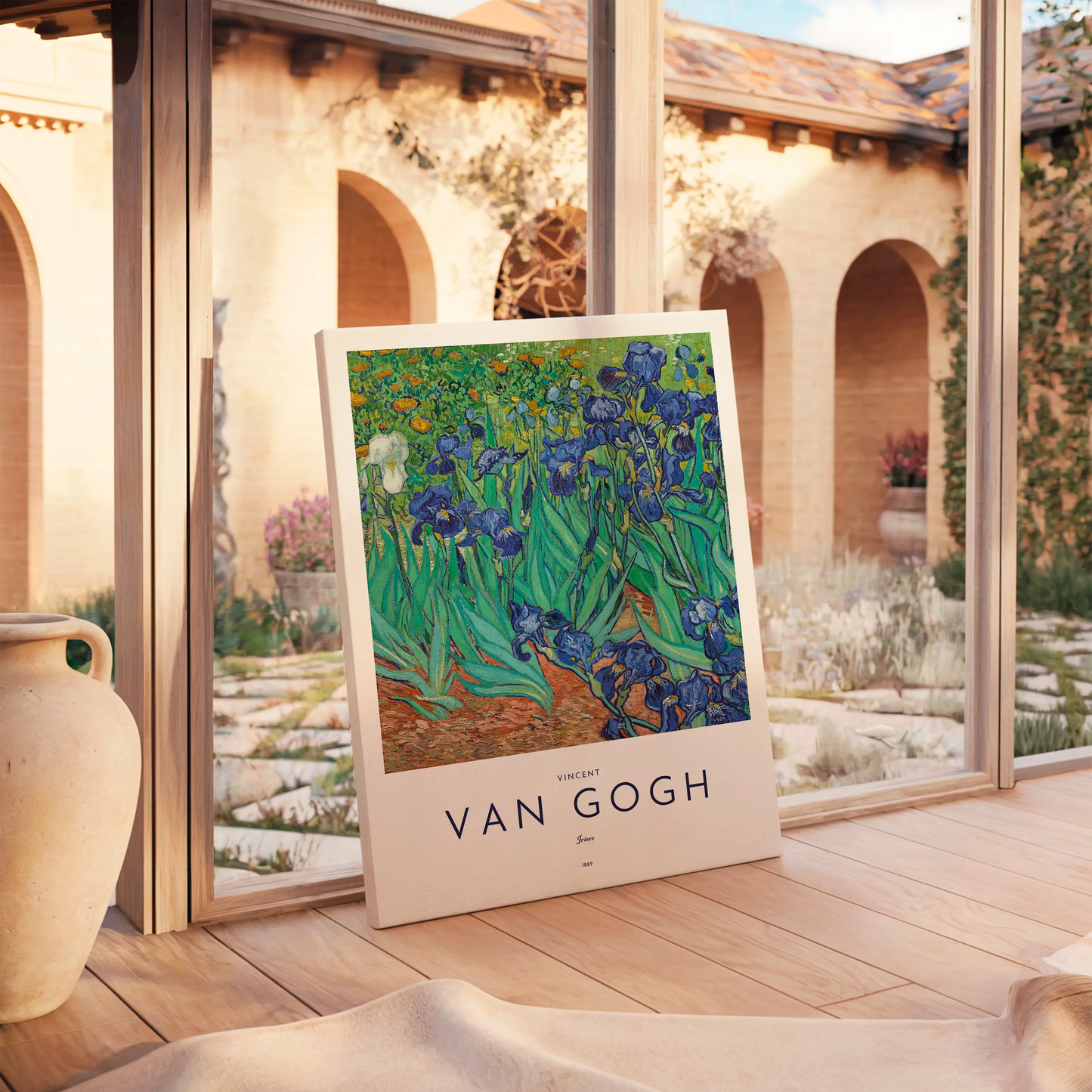Vincent van Gogh - Irises (1889) - Canvas Print N190
Vincent van Gogh - Irises (1889) - Canvas Print N190
Couldn't load pickup availability
Share
Paper Poster | Canvas Print | Digital File
1. Historical and Artistic Context
Vincent van Gogh painted “Irises” in May 1889, just after entering the asylum at Saint-Rémy-de-Provence. At this time, he was seeking stability after a series of mental health crises. Surrounded by gardens and nature in the former monastery, he found comfort in the vibrant flowers. “Irises” was one of the very first works he created during his stay, inspired directly by the blooms outside his window. Though he considered it a simple study, the painting became a profound reflection of his state of mind and artistic vision.
2. Technical and Stylistic Analysis
The painting presents a close-up view of blossoming irises, filling almost the entire canvas. Van Gogh cropped the scene so that the flowers dominate, leaving no sky visible. The composition emphasizes rhythm and movement: curved leaves and petals create a dynamic pattern. The deep blues and greens of the irises contrast with the warm ochres and yellows of the soil and background flowers, producing a vivid harmony. His swirling, confident brushstrokes give the plants a sense of motion and life, capturing energy rather than static representation.
3. Symbolism and Interpretation
“Irises” has often been read as a meditation on life, hope, and individuality. The single white iris among a sea of purple-blue blossoms suggests uniqueness, isolation, and perhaps Van Gogh’s own sense of being different. The varying stages of bloom — budding, flowering, and wilting — symbolize the cycle of life and mortality. The absence of sky or horizon emphasizes confinement, echoing Van Gogh’s own restricted world in the asylum. Yet, the vitality of the flowers conveys resilience and beauty, making the work both therapeutic and expressive of his inner struggles.
4. Technique and Materials
Van Gogh painted “Irises” with oil on canvas using his signature impasto method. He applied thick, textured layers of paint, giving a tactile, almost sculptural quality. His bold outlines around petals and leaves reveal influence from Japanese ukiyo-e prints, which he admired. The color palette originally featured more purples, but the red pigments faded over time, leaving many flowers looking blue today. Scientific analysis has shown that the painting once had brighter contrasts, with more intense reds and oranges, demonstrating Van Gogh’s deliberate use of complementary colors to enhance vibrancy.
5. Cultural Impact
“Irises” holds a central place in Van Gogh’s legacy and in modern art history. It helped redefine the genre of floral painting by shifting focus from decorative still life to expressive, emotional landscapes. The image of irises, pulsing with life, has become iconic, appearing in books, posters, and exhibitions worldwide. When the painting sold at auction in 1987 for $53.9 million, it drew massive global attention and became one of the most expensive works ever sold, further cementing its cultural significance and Van Gogh’s posthumous fame.
6. Critical Reception and Scholarly Interpretations
When Theo van Gogh exhibited “Irises” in 1889 at the Salon des Indépendants, it was praised for its vitality and originality. Critics admired the freshness of the floral study, with Octave Mirbeau describing it as evidence of Van Gogh’s deep understanding of nature. Scholars later noted its therapeutic function, with Van Gogh himself calling it a “lightning conductor” for his illness. Some interpretations focus on the lone white iris as an emblem of individuality, while others emphasize the Japanese influence and the painting’s decorative, almost abstract qualities.
7. Museum, Provenance and Exhibition History
The painting’s journey is remarkable. In 1892, critic Octave Mirbeau purchased it for 300 francs. Later, it passed to fashion designer Jacques Doucet, and eventually to American collector Joan Whitney Payson. In 1987, it was sold at Sotheby’s for $53.9 million to Alan Bond, who could not pay, leading to its transfer to the J. Paul Getty Museum in 1990. Since then, “Irises” has been one of the highlights of the Getty’s collection in Los Angeles, where millions of visitors admire it each year.
8. Interesting Facts
1. Painted in May 1889, shortly after Van Gogh entered the asylum.
2. One of the first works created at Saint-Rémy.
3. Van Gogh considered it only a study, not a finished masterpiece.
4. Theo exhibited it in Paris at the Salon des Indépendants in 1889.
5. Originally had more purples; red pigments faded to blue.
6. The single white iris stands out symbolically and visually.
7. First owned by French critic Octave Mirbeau.
8. Sold in 1987 for a record $53.9 million.
9. Now part of the Getty Museum’s collection in Los Angeles.
10. Scientists discovered hidden color changes using ultraviolet light.
9. Conclusion
Van Gogh’s “Irises” is more than a floral painting — it is a profound statement of resilience, individuality, and beauty created in the midst of personal turmoil. Through bold colors, swirling brushstrokes, and symbolic contrasts, Van Gogh turned a simple garden scene into a universal meditation on life. Its cultural journey, from the asylum garden to record-breaking auctions and the Getty Museum, underscores its lasting power. Today, “Irises” continues to inspire viewers with its message that even in the darkest times, art and nature can bring light and healing.











